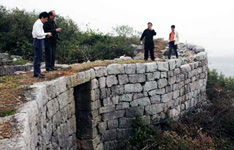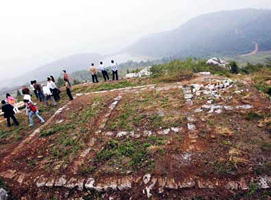Mysterious ancient castles discovered in Hunan
From:China.org.cn NetWriter:Date:2007-10-19
Stretching for miles, Daguan Mountain Rage meanders in the southeast of Xintian County of Hunan Province. At the top of the rage perches an ancient castle whose owner remains an enigma.
On October 13, an archeological team from the provincial Bureau of the Preservation of Cultural and Historical Relics hit the newly discovered castle site and carried out a careful surveying work, according to a Xiao Xiang Morning News report on October 16.
The castle ruin has been maintained in perfect condition. Together with other five “satellite castles” located in its close vicinity, it forms an imposing castle group.

Situated 20 kilometers southeast to Xintian County, the castle just nestles at 685 meters above sea level, the highest in the mountainous area.
There are 17 tofts measuring 7,000 square kilometers. The rounded inner walling is 346 meters long and 4 meters high (previously 5-6 meters). The castle has gates on its east, west and north sides.
There are two cisterns used to store water fetched from down the mountain. The overall castle was built by fine green slates, each of them weighing at least one hundred kilograms, requiring a complex masonry work. The slates were bound togther by a kind of compound adhesive (a mixture of lime, glutinous rice and tung oil).
“The compound adhesive was usually used in the building in the Ming Dynasty,” He Qiang, vice director of the bureau, told to the reporter. In such connection, he inferred that it was possibly built in the Ming Dynasty.
After further survey, the experts found another castle group adjacent to the previous one. Such a great archeological coup pulled off for the first time attracted more archeologists.

The Xintian County is remote and sparsely populated. The reason why the owner built those castles which drained a lot of money and manpower in such a remote wilderness deep in the mountains is a mystery.
Some experts inferred that they were built by an honorable person who had a special status and kept low-profile.
And some experts even guessed it served as a sanctuary for the Emperor Zhu Yunwen (the second emperor in the Ming Dynasty) after he stepped down in the wake of a coup. The historical materials revealed that Zhu Yunwen became a fugitive after he was ousted from his regal status.
Xie Wujing, an archeological expert, analyzed that such a complicated architecture cannot be accomplished by the commons or mountain bandits. If it was constructed by a high official, why did he seclude it from the outside by building it high on the mountains?
“We cannot find any record about the castles in the local annals which even put down the account of a small mountain stronghold,” Xie’s remark threw the origin of the castles into considerable doubts again.
He Qiang said that apparent evidence divulged that the castles were probably built for fortification. “For example, they were built in the highland and commanded broad views. There are ruins of gun muzzles and large cistern,” he added. “The discovery will provide a better perspective in the southern Hunan Province’s military history research in the Ming and Qing Dynasties.”

